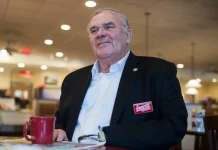-
To improve Indiana’s voter participation, Hoosiers might first have to get to know their neighbors better.
The recently released 2023 Indiana Civic Health Index highlighted Indiana’s lackluster voter registration and turnout numbers and ignited a renewed push to encourage people – particularly those who just turned 18 – to register so they can vote in the 2024 election. But Ellen Szarleta, one of the principal authors of the index, notes the apathy toward voting might be a symptom of Hoosiers having too few connections with their neighbors and communities.
Szarleta, director of the Center for Urban and Regional Excellence at Indiana University – Northwest, cautioned that more research must be done on Indiana, specifically, but, in general, the data indicates that in regards to civic health, low social connectedness is linked to lower levels of civic participation. In other words, people who have strong relationships with other people and organizations in the community are more likely to go to the polls on Election Day.
 “I think this is something that we have to take a close look at specifically in the state of Indiana and if we are staying home, if we’re lacking that connection to others, not seeing what we call our place in the community or having a sense of community,†Szarleta said. “The research is showing that that’s going to make us less likely to participate in those activities that are formal civic activities like registration and voting.â€
The 2023 index reported that Indiana’s voter turnout ranking sank from 41st in 2016 to 46th in 2020 among all states, plus the District of Columbia. In the 2020 November election, 61% of Hoosiers, when questioned through the U.S. Census Current Population Survey Voting Registration Supplement project, said they voted. This compares to the turnout average of 75.2% in the top 10 states with the highest voter participation.
Conversely, Indiana’s rankings on social connectedness and civic awareness are much better. Stats, cited in the 2023 index, show the Hoosier state’s ranking improved in membership to a group of any kind from 17th in 2020 to 16th in 2022 and in attending a public meeting from 37th in 2020 to 35th in 2022. During that same period, the state’s rank for volunteering dipped from 18th to 21st.
However, Szarleta pointed out the higher rankings are not indicative of better participation. Despite Indiana’s rise in some rankings, the percentage of Hoosiers belonging to a group or attending a public meeting actually fell from 2020 to 2022. Group membership dropped from 32.7% to 29.4%, while attending a meeting fell from 9.6% to 8.1%.
Even the numbers behind the slip in the volunteer ranking show a steep decline of nearly 7 percentage points, decreasing from 34% in 2020 to 27.6% in 2022.
Moreover, neighborliness dropped in the past decade. The percentage of Hoosiers talking to or spending time with their neighbors plunged from 34.8% in 2012 to 26.4% in 2022, while doing favors for neighbors sank from 13.5% to 9.5% during the same time period.
“The bigger question is, is that satisfactory?†Szarleta asked. “Is that really where we want to be? Forget that we’re doing better than some of the states.â€
Participation leads to positive outcomes
Standing in the Indiana Statehouse recently, Lana Bose, of Charlestown, was nervous about having to talk to lawmakers, but she was motived by her own battle with cancer and her desire to help others.
“I’m very nervous,†Bose said. “I’m nervous because I’ve never done this before.â€
Previously, Bose had not been very civically engaged. She is a member of Southeast Christian Church and connects with neighbors on Facebook. However, she had driven to the Statehouse on a rainy, foggy morning to tell her story of a protracted fight against stage 4 colon cancer that culminated in June of 2016 with a doctor’s prognosis that she would die before the end of that year. What enabled her to reverse course and become a five-year cancer survivor, she said, was biomarker testing.
Bose, a member of the American Cancer Society, was in Indianapolis with other cancer survivors to advocate for Senate Bill 273. Authored by Sen. Ed Charbonneau, R-Valparaiso, the bill requires health care plans to provide coverage for biomarker testing.
Bose and the other members of the group began their day at the Indiana General Assembly by listening to remarks of encouragement and advice from a handful of legislators and advocates. Then they gathered for a group photo and enjoyed a box lunch, before attending a legislative committee hearing on SB 273.
“I think that everybody needs to have the ability to have this testing, so that they do have a quality of life, so they do live full lives,†Bose said. “So coming up here, I was excited to be part of it, where I never thought that I would be in this place or even be here. So my story, I hope, makes a difference.â€
SB 273 has picked up bipartisan support and passed through the Indiana Senate on a 47-to-1 vote. The bill is now progressing through the lower chamber, passing the House Insurance Committee on Wednesday and moving on to the House Ways and Means Committee.
Although the degree of participation in Indiana is not at high levels, Szarleta said Hoosiers are willing to be engaged in their communities. They understand the importance of being socially connected, she said, but, to get more people to advocate like Bose, Indiana should take a deeper look at the opportunities and the barriers to increasing civic engagement.
The benefit of more social connectedness would be improved civic health, Szarleta said. This would, in turn, she said, result in higher levels of educational attainment, better health, lower crime rates, and other positive outcomes.
Szarleta reiterated that voting participation is intertwined with civic participation. Voters, she said, should not see voting as a means to get what they want politically, but, rather, as part of their responsibility as members of a democracy.
“It’s not just voting and voter registration,†Szarleta said. “We can’t separate those out from civic awareness, which is that knowledge which gives you the ability to participate, and social connectedness, which gives you the intent, the motivation, that willingness to be part of the whole. When you don’t see those coming together, that’s, I think, how we get to the result that we have right now with voting and voter registration being at 50 and 40 in our rank.â€
This article was published by TheStatehouseFile.com through a partnership with The Indiana Citizen, a nonpartisan, nonprofit platform dedicated to increasing the number of informed, engaged Hoosier citizens.
Indiana Citizen Editor Marilyn Odendahl has spent her journalism career writing for newspapers and magazines in Indiana and Kentucky. She has focused her reporting on business, the law and poverty issues.
Dwight Adams, a freelance editor and writer based in Indianapolis, edited this article. He is a former content editor, copy editor and digital producer at The Indianapolis Star and IndyStar.com, and worked as a planner for other newspapers, including the Louisville Courier Journal.





